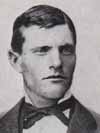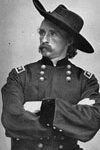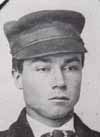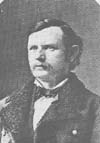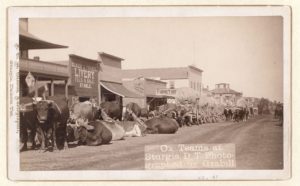David W. Lewis was born on February 18, 1852, in St. Louis, Missouri. He was a Private in Company B who was not present at the Battle of the LIttle Bighorn because he was confined.
William Othniel Taylor was born in Canandaigua, Ontario County, New York, on February 18, 1855. He was a Private in Company A who participated in the valley and hilltop fights. He died in Orange, Massachusetts, on February 19, 1923, and was buried in the Central Cemetery there.
 Alexander Brown (left) was born on February 19, 1844, in Aberdeen, Scotland. He was a Sergeant in Company G and was with the pack train and in the hilltop fight.
Alexander Brown (left) was born on February 19, 1844, in Aberdeen, Scotland. He was a Sergeant in Company G and was with the pack train and in the hilltop fight.
Thomas Hughes, who was also known as Charlie Hughes, was born in County Mayo, Ireland, on February 21, 1845. He was a Private in Company H who was wounded in the hilltop fight.
Charles Ackerman married Ephresina Peterson on February 21, 1881, at Fort Totten. He was a Private in Company K who was not present during the battle due to detached service at the Powder River Depot.
Michael Vincent Sheridan died on February 21, 1918, in Washington, D.C., and was buried in Arlington National Cemetery. He was a Captain in Company L who was not present due to detached service. He was the brother of General Philip Henry Sheridan. He was the brother of General Philip Henry Sheridan. Michael died the day after Philip’s funeral.
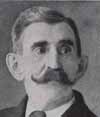 Dennis Lynch (left) was born on February 22, 1848, in Cumberland, Maryland. He was a Private in Company F who was not at the battle due to detached service.
Dennis Lynch (left) was born on February 22, 1848, in Cumberland, Maryland. He was a Private in Company F who was not at the battle due to detached service.
William Gavin Capes was born in Portland, Maine, on February 22, 1849. He was a Sergeant in Company M who was not present due to detached service.
Andrew Humes Nave was born in Knoxville, Tennessee, on February 23, 1846. He was a Second Lieutenant in Company I, but he was not present at the battle due to illness.
Jan Moller, who was also known as James Moller, died on February 23, 1928, in Deadwood, South Dakota, and was buried in the Mount Moriah Cemetery there. He was a Private in Company H who was wounded in the hilltop fight.
George A. Rudolph was born in Meuterheim, Germany, on February 24, 1854. He was a Private in the Band and was not present at the battle due to detached service at Powder River, Montana.
Charles Louis Haack died on February 24, 1902, at the Soldiers Home in Washington, D.C., and was buried in its National Cemetery. He was a Private in Company I who was not present at the battle due to illness.
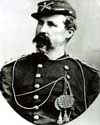 Joseph Greene Tilford (left) died in Washington, D.C., on February 24, 1911, and was buried in Arlington National Cemetery. He was a Major who was not present at the battle due to detached service.
Joseph Greene Tilford (left) died in Washington, D.C., on February 24, 1911, and was buried in Arlington National Cemetery. He was a Major who was not present at the battle due to detached service.
